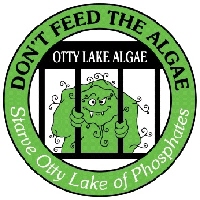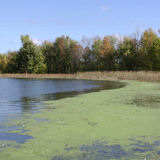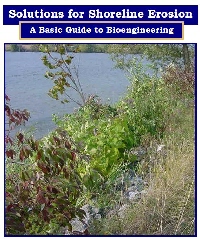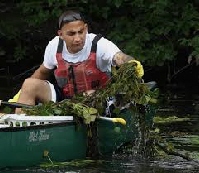Other Water Issues
Potential Harmful Algal Blooms (including Blue Green Algae | Starving the Lake of Phosphorus | Water Levels | Shoreline Erosion | Aquatic Plant Control
Potentially Harmful Algal Blooms (including blue green algae)
from the Leeds, Grenville and Lanark District Health Unit, August 23, 2021
Potentially harmful algal blooms including blue-green algae are a natural seasonal phenomenon that may appear in our lakes, rivers and ponds. Many of these blooms are relatively harmless; however, some species have the potential to produce toxins which may be harmful to people and animals. The presence of a harmful algal bloom and its toxins can only be confirmed through a laboratory test, so we recommend taking a cautious approach when you suspect a potentially harmful algal bloom. Toxins are released when algal cells break down. These toxins when released can cause skin irritation, nausea and vomiting, and in higher concentrations, liver problems
The Health Unit advises people using surface water for recreation and drinking, to become familiar with potentially harmful algae so they can make informed decisions on when to avoid contact with the water. Algae blooms do degrade with time; however, it is not possible to say whether the toxins have completely left the area. Once the toxin is released from the cell, where it goes depends on the local characteristics of water movement in the area. The toxin will eventually be diluted into the body of water as any other soluble compound.
Drinking Water
Surface water is never a safe source of drinking water without effective treatment. The toxins released by harmful algae are not removed by commonly used treatment methods such as boiling, chlorination or ultraviolet light treatment. Surface water requires specialized treatment. Consult a water treatment specialist if your drinking water comes from a surface body of water such as a lake or river. You may want to choose another source of water for drinking.
Recreational Water Use
Avoid activities that increase your exposure to toxins in the water during an active algae bloom. When deciding whether to resume recreational use of the water after a harmful algae bloom (swimming and water sports) consider the following factors:
- Faster moving water will dilute and move the toxins out of an area more quickly, further decreasing the risk to health. Each property will have a different water flow pattern, so a local assessment is useful to further assess risk.
- Skin irritation is the first sign that the level of toxin is significant in the water, so if this occurs, it is important not to go in the water. A few more days will help to clear the water if it is moving well, unless another bloom has occurred.
- Bacteria, viruses and other microbes that can affect health are commonly found in surface water such as lakes and rivers, so it is important not to swallow the water. Young children are more likely to swallow water so they should be watched carefully when playing or swimming in the water.
- Be cautious about eating fish caught in water where a harmful algae bloom has occurred. Toxins are concentrated in the liver. So avoid consuming the liver, kidneys and other organs of fish caught in an area affected by potentially harmful algae.
Algae exist in nature; however, nutrient levels can contribute to an increase in blooms of algae. You can help reduce nutrient levels entering water bodies by reducing the use of household fertilizers, agricultural runoff, and ensuring your septic system is in good working order.
Residents are encouraged to contact the Spills Action Center at 1-800-268-6060 to report any new potentially harmful algae blooms. If possible take pictures of an active bloom as this may help identify the type of algae. This way the location and number of blooms can be monitored.
For more information about harmful algal blooms including blue-green algae, visit our Recreational Water page or call 1-800-660-5853. You can also connect with us on Facebook and Twitter @LGLHealthUnit for important public health updates.
Let’s Starve Algae in Otty
 Algae – the Annual Loathsome Green Aquatic Eyesore. While this acronym isn’t a scientific description of the plague we experience every year, it does capture the prevailing sentiment about those ugly green blobs that appear at docks. Like all living things, algae need certain conditions to survive. They thrive in hot weather and prefer quiet water unaffected by wind. Algae also require nutrition, especially phosphorus.
Algae – the Annual Loathsome Green Aquatic Eyesore. While this acronym isn’t a scientific description of the plague we experience every year, it does capture the prevailing sentiment about those ugly green blobs that appear at docks. Like all living things, algae need certain conditions to survive. They thrive in hot weather and prefer quiet water unaffected by wind. Algae also require nutrition, especially phosphorus.
To reduce or even rid Otty of the green slime we all hate there’s a simple solution – starve Otty of phosphorus run-off.
See story in June 2013 Newsletter
Water Levels
Water Levels and the Health of Otty Lake – March 2010
While some have expressed their concern about “high” water levels, others have been equally concerned about periods of “low” levels. There has been much discussion over the years, and the OLA has consulted with RVCA, MNR and Fisheries and Oceans to better understand what influences the water levels and health of Otty Lake.
Lake Water Levels and Lake Health
Lake water levels will not affect the rate of removal of nutrients from the lake . A complete exchange of the water from Otty Lake takes between 3 and 4.5 years. Hence the removal of nutrients in the lake has to be considered over this longer timeframe rather than on a seasonal basis.
Weather
The weather has significant impact on Otty Lake water levels. Hot, dry and windy weather can result in lower lake levels due to increased evaporation from the lake surface and reduced water input. When the weather is cool, overcast and rainy, lake levels are higher.
 Green Algae
Green Algae
The “green slime” normally seen in the lake in the early summer is a form of algae. It is not caused by the lake needing to be able to flush itself through Jebbs Creek. It occurs when there is a lot of rain washing nutrients from the land into the water. It flourishes in the cooler damp weather we often have early in the year.
Beavers
In 2009 the major land owners bordering Jebbs Creek regularly breached beaver dams and trapped beavers along their areas of the Creek. We understand that they will continue with this practice. However, Jebbs Creek is a natural habitat for beavers and beavers will regularly re-colonize a suitable waterway. We will continue to monitor what is happening in Jebbs Creek.
Impact on Shoreline Structures
Structures constructed during periods of low water levels will always be challenged in times of high water levels. As well, these structures harden the shoreline. Hardened shorelines deflect wave energy instead of absorbing it – the energy is deflected to the sides passing the erosion problem on to neighbouring sites and down, scouring away any sediment or plant life near the base of the wall. For docks with adjustable legs are recommended.
Impact on Trees
The Otty Lake Association is monitoring closely the potential impact of water levels on trees along the lake shoreline. For the most part, the higher water levels did not seem to be having a negative impact on the shoreline but we did document areas where trees were impacted and reported our observations to the RVCA. Monitoring of the lake shoreline will continue.
Regulatory (1:100 year) Flood Level for Otty Lake
An RVCA analysis, completed in 2011, attempted to estimate the 1:100 year flood level around Otty Lake, in order to provide a basis for RVCA’s regulations re structure placement and flood proofing. Exact delineation was not possible due to the absence of full topographical data. Read the study.
Shoreline Erosion
Erosion is a natural process, but it can be accelerated by human activity like the removal of shoreline vegetation or excessive boat wake. Natural vegetation along our shorelines plays a crucial role in preventing soil erosion, protecting water quality and preserving the ecological balance of aquatic environments. Without a healthy vegetated buffer, shorelines have reduced resistance against erosion.
 A handbook is available to guide people on how to bring buffers back to their shore and fight erosion naturally. The Solutions for Shoreline Erosion Handbook goes beyond the traditional approaches to reduce erosion such as riprap or seawalls; it highlights options that use natural materials. Great for lakes, rivers, streams, creeks and drains across Eastern Ontario, the booklet shows different methods for different sites based on slopes, soils and space. It outlines the advantages and disadvantages of each method and includes contact information for agencies where permits and/or approvals might be necessary before starting a project.
A handbook is available to guide people on how to bring buffers back to their shore and fight erosion naturally. The Solutions for Shoreline Erosion Handbook goes beyond the traditional approaches to reduce erosion such as riprap or seawalls; it highlights options that use natural materials. Great for lakes, rivers, streams, creeks and drains across Eastern Ontario, the booklet shows different methods for different sites based on slopes, soils and space. It outlines the advantages and disadvantages of each method and includes contact information for agencies where permits and/or approvals might be necessary before starting a project.
Aquatic Plant Control
Aquatic plants are an important part of a natural aquatic ecosystem, especially in the ecology of shoreline areas. They provide habitat for fish to spawn, feed and hide from predators. Aquatic plants help maintain water quality by stabilizing sediments. But having too many aquatic plants can interfere with boating, swimming and other recreational water activities, and at times, some control may be necessary.
Regulations for Aquatic Plants
The beds of most water bodies in Ontario are legally public land. In order to remove aquatic plants by physical or mechanical methods, approvals from one or more agencies and a work permit from the applicable authority may be required. To obtain approval for in‐water and shoreline works in our area, your first contact should be the Rideau Valley Conservation Authority.
Control Methods for Aquatic Plants
- Raking
- Removal by hand
- Mechanical harvesting
- Cutter‐bar devices
- Bottom barriers (mats or blankets)
- Chemical methods (herbicides)
 To preserve fish habitat, hand removal and raking are the preferred methods. Warm-water fish species spawn during spring and early summer, so do not remove aquatic vegetation during the timing moratorium, March 15 – June 30. Any plants removed should be disposed of well above the average high water mark.
To preserve fish habitat, hand removal and raking are the preferred methods. Warm-water fish species spawn during spring and early summer, so do not remove aquatic vegetation during the timing moratorium, March 15 – June 30. Any plants removed should be disposed of well above the average high water mark.
MNR Regulations – Jan. 1, 2014
The Ministry of Natural Resources specifies rules for removing native aquatic plants that occur naturally in Ontario. As Otty Lake is south of the line indicated on their map, property owners or their agents are entitled to remove, without a permit, aquatic vegetation in front of their property, as specified in the regulations, provided that various conditions are met. This applies to removal of aquatic vegetation by both hand and mechanical means. The ministry specifies how wide an area you may clear depending on whether the width of your shoreline property is greater than or less than 22 m., and also allows for a boat channel if the weeds need to be cleared more than 30 m. from shore. A person also has the option of applying for a work permit if the area to cleared is larger than the conditions described above.
The RVCA has installed a real time water level gauge to monitor lake levels.
Ice Out Dates
Ice-out date was April 3, 2016 this year. Thanks to the record keeping of some Otty Lake residents, we have a record of ice out dates for 1986-2016. The earliest ice-out in this period was March 23, 2012 and the latest was April 26, 1992. If you have older dates to report, please contact the Lake Steward.

Water Levels